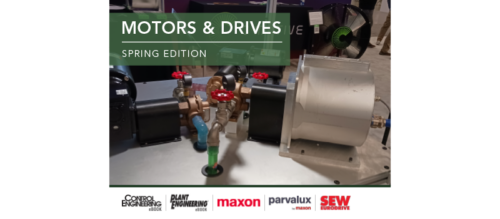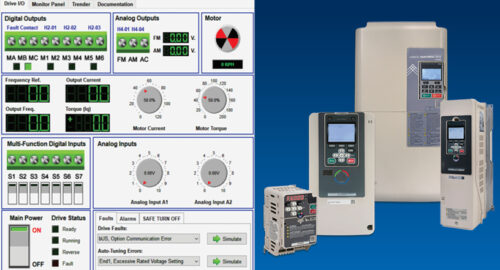Preventing overvoltage tripping of adjustable-speed drives
Adjustable-speed drives (ASDs) are affected by two major types of power supply disturbances: voltage sags and transient overvoltages.
Adjustable-speed drives (ASDs) are affected by two major types of power supply disturbances: voltage sags and transient overvoltages. The control/protection logic of modern ASDs trips the drive off-line if the dc bus voltage drops below a preset minimum voltage level or above a preset maximum voltage level.
The undervoltage protection mode is based on the ability of the ASD to supply the required energy to the load at reduced voltage. The overvoltage protection mode is based on the capability of the transistors or insulated gate bipolar transistors used in the inverter section of the drive to withstand overvoltage.
While tripping of ASDs due to voltage sags can occur during fault conditions (either inplant or in the utility’s system), tripping due to transient overvoltages resulting from capacitor switching (either inplant or on the utility’s system) can occur far more frequently, thus becoming a real nuisance.
Nuisance tripping of a single ASD can result in major process interruptions and, especially if there are frequent occurrences (in some cases as many as once every day), can be quite costly.
Effects of capacitor-switching transients
Switching of shunt capacitor banks results in transient overvoltages at the switched capacitor location and elsewhere in the electrical system connected to the capacitor circuit. These transient overvoltages have a typical peak amplitude of 1.6­1.8 times the normal peak system phase-to-ground voltage, and a characteristic frequency which is typically in the range 300­800 Hz (Fig. 1).
In certain cases, capacitor switching transients can be magnified at other capacitor locations, especially at power-factor-correction capacitors used in industrial plants (Fig. 2). This phenomenon, known as voltage magnification, is a result of the sympathetic oscillation of an inductive capacitive (LC) circuit, formed by the inductance between the two capacitor locations (Fig. 3) and the capacitance of the power-factor correction capacitors (Fig. 4).
Amount of magnification depends on the relative size of the capacitors, frequency of oscillation of the two LC circuits, and damping provided by loads connected to the capacitor circuits.
Whether magnified or not, capacitor-switching transient overvoltages applied to the input line terminals of voltage-source-inverter-type ASDs cause an inrush of current into the large dc bus capacitor which is used to stabilize the dc bus voltage of this type of ASD. Inrush current, if not limited by impedances in the circuit, causes a rapid charging of the dc bus capacitor, resulting in an overvoltage on the dc bus of the ASD (Fig. 5).
If the transient overvoltage on the dc bus exceeds the preset overvoltage trip level of the ASD, the overvoltage protection circuitry of the ASD trips the drive off line. Some ASDs trip at dc bus voltage levels as low as 116% of the nominal dc bus voltage level, while others may have a slightly higher overvoltage trip setting which is usually not more than 126% of the nominal dc bus voltage.
Small-horsepower ASDs, larger than 5 hp, typically use a small dc bus choke to reduce the harmonic current content of the drive. If present, the dc bus choke slows the charging of the dc bus capacitor during the transient somewhat, but usually not enough to prevent nuisance tripping of the ASD. While some transient energy is removed by the load connected to the drive, the charging of the dc bus capacitor is usually so rapid the load does not have a significant effect on the initial magnitude of the dc bus transient overvoltage.
Preventing nuisance tripping
Capacitor-switching transient overvoltages applied to the line input terminals of the ASD can be reduced in several ways. Several factors, including the number and horsepower ratings of the ASDs affected and the economic impact of the nuisance tripping of the ASDs, determine the most effective and economical solution.
If only a small number of ASDs are affected, the most economical solution involves the addition of either three-phase ac line chokes or an isolation transformer to the input terminals of each of the drives affected (Fig. 6). The mainly reactive impedance of the chokes or the isolation transformer serves to reduce the amount of current flow during an overvoltage transient, resulting in a slowing of the charging of the dc bus capacitor, allowing the load to remove most of the transient energy.
In many cases, particularly where capacitor-switching transients are not magnified, ac line chokes or isolation transformers with impedance of at least 3% (based on drive kVA and voltage ratings) would be sufficient to prevent nuisance tripping of ASDs. The chokes and isolation transformers have the additional advantage of reducing the overall harmonic content of the ac line current supplied to the drive. However, in some cases where severe voltage magnification occurs and ASDs have low overvoltage trip settings, the addition of ac line chokes or isolation transformers alone are not sufficient to prevent nuisance tripping.
If nuisance tripping can be attributed to voltage magnification occurring at medium or utilization voltage capacitor banks, the banks involved can simply be disconnected. However, this disconnect nullifies the original intent of the capacitor banks, which was to reduce the overall kVA demand by providing some reactive power to the load. This approach obviously increases the facility’s electrical bill (due to increased kVA demand and possibly due to additional charges for low power factor) which may not be an economical solution at all.
A more practical solution, especially if a large number of ASDs are involved, would be to convert the capacitor bank to a harmonic filter. This solution effectively detunes the LC circuit involved in voltage magnification and absorbs more of the overvoltage within the filter (across the capacitor units), reducing the transient overvoltages on the utilization voltage buses located throughout the facility.
The harmonic filter can be designed to sink harmonic currents generated by ASDs (e.g., the fifth harmonic), reducing the harmonics injected into the utility’s system. This solution is fairly costly and may, in some cases, involve a complete upgrade of the existing power-factor correction capacitor units due to the possibility of increased voltage rating requirements.
In cases where a large number of ASDs are involved and the use of ac line chokes or isolation transformers are either not effective or economical, reduction of the capacitor-switching transient at the switched capacitor location may be the only effective and economical solution.
For subtransmission and transmission utility capacitor banks, circuit-switchers with pre-insertion inductors, circuit breakers with pre-insertion resistors, or circuit breakers or vacuum interrupters with controlled closing can be used to energize capacitor banks and diminish capacitor-switching transients.
Pre-insertion inductors, inserted into the capacitor-energizing circuit for 6­12 cycles during closing, are used to reduce the initial collapse in the bus voltage and damp the oscillatory transient, which results in the characteristic 300­800-Hz oscillation. Specially-designed, high-resistance, pre-insertion inductors are often used to diminish transients effectively and avoid nuisance tripping of ASDs.
Pre-insertion resistors are used in a similar manner with circuit breakers to reduce transients. Controlled closing circuit breakers or vacuum interrupters (also known as synchronous closing or zero voltage crossing switching devices) attempt to minimize capacitor switching transients by closing each of its three poles near a voltage zero. If closing can be achieved within approximately 1 ms of voltage zero on each pole during each closing operation, these devices can generally be effective at preventing nuisance tripping of ASDs.
The choice of a particular switching device and associated means of transient reduction is determined by a number of factors, including overall installation cost, reliability, effectiveness in reducing transients, and ability of the device to interrupt capacitive currents without restriking.
Restriking, defined as a re-establishment of current flow a quarter cycle or longer after initial current interruption (due to dielectric breakdown in the switching device during opening), can result in severe transients during de-energization of the capacitor bank. If restrikes occur in the capacitor-switching device during opening, the usefulness of transient reduction devices during closing is nullified. In many cases, detailed transient simulation studies are performed to assess the effectiveness of each type of device in preventing nuisance tripping of ASDs. If nuisance tripping is attributed to switching of utility distribution capacitor banks or plant medium voltage capacitor banks, devices similar to those described can be used to diminish capacitor-switching transients.
— Edited by Joseph L. Foszcz, Senior Editor, 630-320-7135, jfoszcz@cahners.com
Magnified overvoltage sources
Oscillation at the switched capacitor location acts as a driver for the oscillation at the remote capacitors, resulting in magnified overvoltages. This magnification occurs between:
– Utility substation capacitor banks and pole-mounted distribution capacitor banks
– Utility substation capacitor banks and industrial power-factor correction capacitors (installed at medium or utilization voltage)
– Utility pole-mounted distribution capacitor banks and industrial power-factor correction capacitors
– Medium-voltage and utilization-voltage power-factor correction capacitors within the industrial plant.
More info
The author is available to answer questions on capacitor switching transients. He can be reached at 773-338-1000.
Do you have experience and expertise with the topics mentioned in this content? You should consider contributing to our CFE Media editorial team and getting the recognition you and your company deserve. Click here to start this process.





